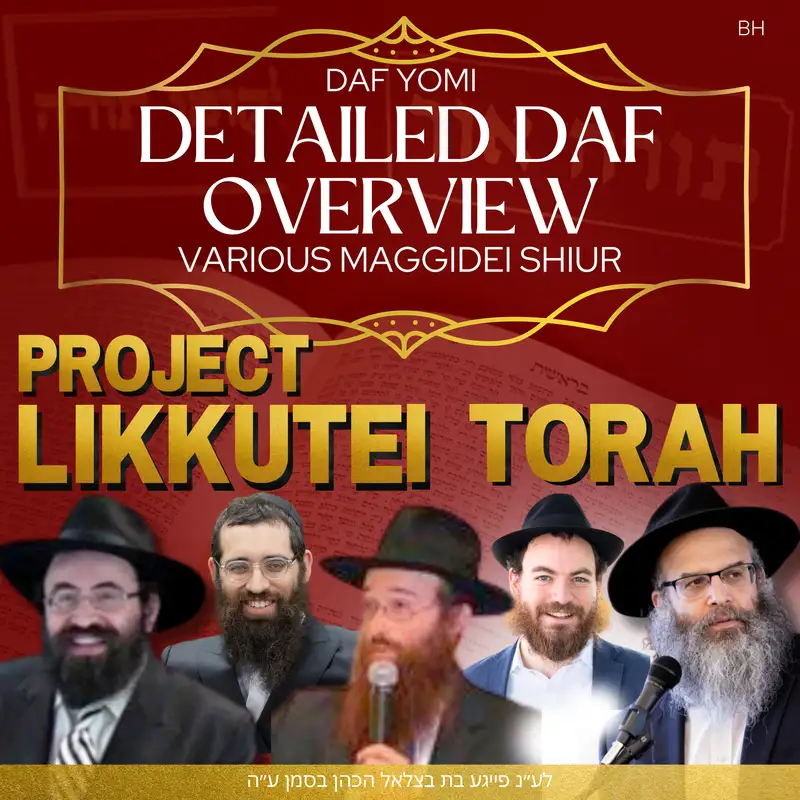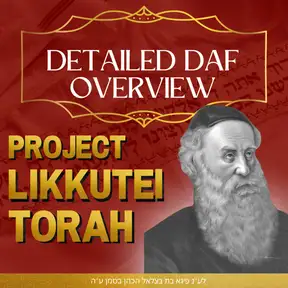
Torah Ohr Daf 34 end of t"r Mitzvas Ner Chanukah beginning of Ki Imcha...
Summary
w/ Rabbi Dovid Leib ShmerlingThe Greeks defiled the Wisdom of Torah. To overcome that, the Jews had to draw from a level that is beyond Wisdom (MMK”A). This was through Mitzvot, which drew from SOK”A, Rav Chessed, which is represented by the single flask of oil. We can now understand the opinions of Beis Shammai (8-1) and Beis Hillel (1-8):Beis Shammai understands that the common aspect of the cattle offerings on Succos and the candles of the Menorah is that they both draw down the level of SOK”A. He learns out the descending order of the latter from the former.Now, although we have just explained that the Menorah does in fact draw down this level, Beis Hillel understands that there is also a difference between these two kinds of service. The former is a Biblical commandment, which means that it relates to the world from the “God’s Eye View” and can effect change just by being present in this world. However, the Menorah is a Rabbinical commandment, which represents the struggle of human beings to bring Godliness into their world from their point of view. This requires a gradual increase in light, through which the darkness itself is slowly transformed. Practically, this means that one needs to refine himself and be committed to serving Hashem before he can fully appreciate and be illuminated by the Mitzvot. (The parallel of this in Pesach and Sefiras Haomer.)An elaboration on the distinction between the seven shepherds and the eight anointed:The seven shepherdsFocus on Torah studyDirectly transmit spiritual sustenance to their flock through teachingOriginate in the deeper layer of a lower level; (Alma D’Isgalya, Chochmah and Binah/”Alafim” of 13 Middos, Pnimi) example: basic fruit vs. superior leaves.The eight anointedAre characterized by their piety and good deedsIndirectly transmit spiritual sustenance through example and other, hidden meansOriginate in an external layer of a higher level (Alma D’Iskasya, the first 8 of the 13 Middos, Makkif) example: superior leaves vs. basic fruitOn Chanukah, we needed to reach beyond the natural, internal mode of spirituality because it had been defiled by the Greeks. And yet, as per Beis Hillel, we do so in an internalized, transformative way.Key ConceptsOr Makkif vs. Or Pnimi (and the way one can have an internal experience of the former).Seven shepherds vs. eight anointed.Ki Imcha Part 1“Ki imcha mekor chaim, b’orcha nireh or”Q1- why “ki imcha” and not “ki ata” ?Q2- what is the significance of the two ways of understanding “nireh or”?The Menorah represents the source of Jewish souls and the seven middos which are constantly present in them, regardless of a person’s actions. “Hamagbii la’shaves, hamashpili liros bashamayim uv’aretz”:1st interpretation: God Himself is completely beyond the reality of our world. And yet, He “descends”, allows Himself to be grasped in this world through Torah and Mitzvot. In Galus, God’s presence in the world is not apparent. In this scenario, the world exists as a body does to a sleeping brain: the fullness of the person/soul (i.e., the Godly force which is the basis of all reality) is not fully expressed [for the value of this mode of existence, see ]. This is what allows for the existence of things which appear to oppose Godliness (e.g., the Greeks). The way we reintroduce Godliness into this world is through Torah (Chochma) and Mitzvot (Chessed). In addition, we need to have conscious intent and emotion (gold) in our fulfillment of Torah and Mitzvot, Support the showw/ Rabbi Dovid Leib Shmerling
- The Greeks defiled the Wisdom of Torah. To overcome that, the Jews had to draw from a level that is beyond Wisdom (MMK”A). This was through Mitzvot, which drew from SOK”A, Rav Chessed, which is represented by the single flask of oil.
- We can now understand the opinions of Beis Shammai (8-1) and Beis Hillel (1-8):
- Beis Shammai understands that the common aspect of the cattle offerings on Succos and the candles of the Menorah is that they both draw down the level of SOK”A. He learns out the descending order of the latter from the former.
- Now, although we have just explained that the Menorah does in fact draw down this level, Beis Hillel understands that there is also a difference between these two kinds of service. The former is a Biblical commandment, which means that it relates to the world from the “God’s Eye View” and can effect change just by being present in this world. However, the Menorah is a Rabbinical commandment, which represents the struggle of human beings to bring Godliness into their world from their point of view. This requires a gradual increase in light, through which the darkness itself is slowly transformed. Practically, this means that one needs to refine himself and be committed to serving Hashem before he can fully appreciate and be illuminated by the Mitzvot. (The parallel of this in Pesach and Sefiras Haomer.)
- An elaboration on the distinction between the seven shepherds and the eight anointed:
- The seven shepherds
- Focus on Torah study
- Directly transmit spiritual sustenance to their flock through teaching
- Originate in the deeper layer of a lower level; (Alma D’Isgalya, Chochmah and Binah/”Alafim” of 13 Middos, Pnimi) example: basic fruit vs. superior leaves.
- The eight anointed
- Are characterized by their piety and good deeds
- Indirectly transmit spiritual sustenance through example and other, hidden means
- Originate in an external layer of a higher level (Alma D’Iskasya, the first 8 of the 13 Middos, Makkif) example: superior leaves vs. basic fruit
- On Chanukah, we needed to reach beyond the natural, internal mode of spirituality because it had been defiled by the Greeks. And yet, as per Beis Hillel, we do so in an internalized, transformative way.
Key Concepts
- Or Makkif vs. Or Pnimi (and the way one can have an internal experience of the former).
- Seven shepherds vs. eight anointed.
Ki Imcha Part 1
- “Ki imcha mekor chaim, b’orcha nireh or”
Q1- why “ki imcha” and not “ki ata” ?
Q2- what is the significance of the two ways of understanding “nireh or”?
- The Menorah represents the source of Jewish souls and the seven middos which are constantly present in them, regardless of a person’s actions.
- “Hamagbii la’shaves, hamashpili liros bashamayim uv’aretz”:
- 1st interpretation: God Himself is completely beyond the reality of our world. And yet, He “descends”, allows Himself to be grasped in this world through Torah and Mitzvot.
- In Galus, God’s presence in the world is not apparent. In this scenario, the world exists as a body does to a sleeping brain: the fullness of the person/soul (i.e., the Godly force which is the basis of all reality) is not fully expressed [for the value of this mode of existence, see ]. This is what allows for the existence of things which appear to oppose Godliness (e.g., the Greeks).
- The way we reintroduce Godliness into this world is through Torah (Chochma) and Mitzvot (Chessed). In addition, we need to have conscious intent and emotion (gold) in our fulfillment of Torah and Mitzvot,
